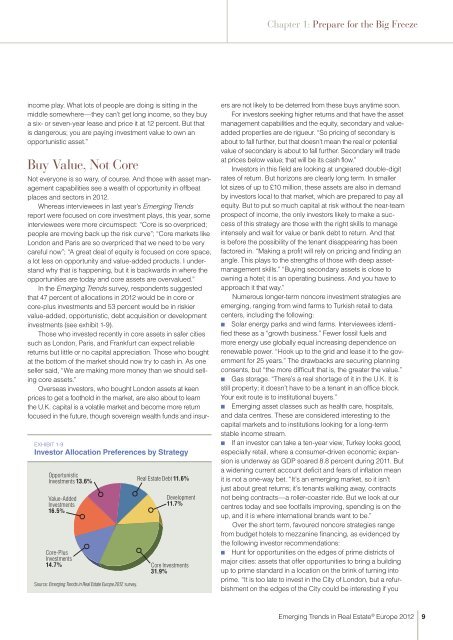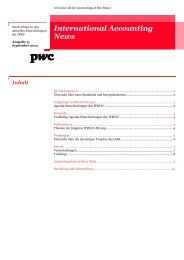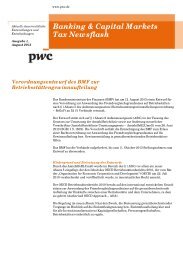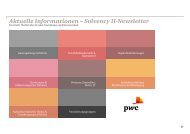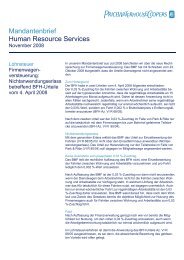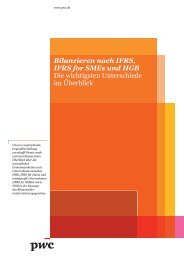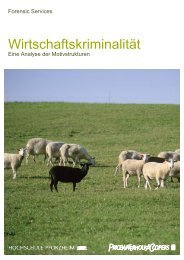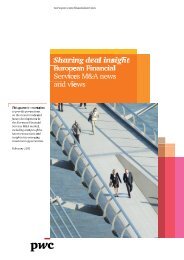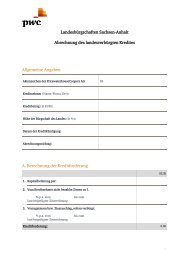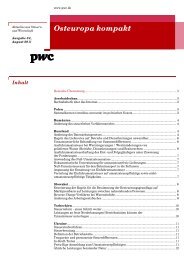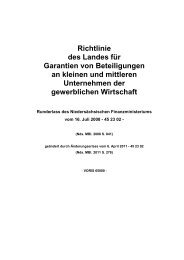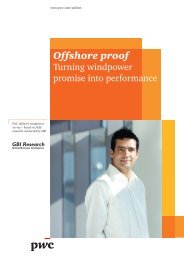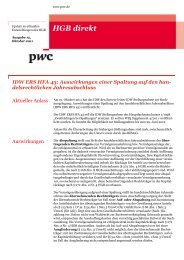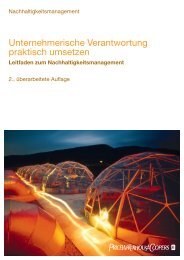Emerging Trends in Real Estate® Europe 2012 - PwC
Emerging Trends in Real Estate® Europe 2012 - PwC
Emerging Trends in Real Estate® Europe 2012 - PwC
You also want an ePaper? Increase the reach of your titles
YUMPU automatically turns print PDFs into web optimized ePapers that Google loves.
<strong>in</strong>come play. What lots of people are do<strong>in</strong>g is sitt<strong>in</strong>g <strong>in</strong> the<br />
middle somewhere—they can’t get long <strong>in</strong>come, so they buy<br />
a six- or seven-year lease and price it at 12 percent. But that<br />
is dangerous; you are pay<strong>in</strong>g <strong>in</strong>vestment value to own an<br />
opportunistic asset.”<br />
Buy Value, Not Core<br />
Not everyone is so wary, of course. And those with asset management<br />
capabilities see a wealth of opportunity <strong>in</strong> offbeat<br />
places and sectors <strong>in</strong> <strong>2012</strong>.<br />
Whereas <strong>in</strong>terviewees <strong>in</strong> last year’s <strong>Emerg<strong>in</strong>g</strong> <strong>Trends</strong><br />
report were focused on core <strong>in</strong>vestment plays, this year, some<br />
<strong>in</strong>terviewees were more circumspect: “Core is so overpriced;<br />
people are mov<strong>in</strong>g back up the risk curve”; “Core markets like<br />
London and Paris are so overpriced that we need to be very<br />
careful now”; “A great deal of equity is focused on core space,<br />
a lot less on opportunity and value-added products. I understand<br />
why that is happen<strong>in</strong>g, but it is backwards <strong>in</strong> where the<br />
opportunities are today and core assets are overvalued.”<br />
In the <strong>Emerg<strong>in</strong>g</strong> <strong>Trends</strong> survey, respondents suggested<br />
that 47 percent of allocations <strong>in</strong> <strong>2012</strong> would be <strong>in</strong> core or<br />
core-plus <strong>in</strong>vestments and 53 percent would be <strong>in</strong> riskier<br />
value-added, opportunistic, debt acquisition or development<br />
<strong>in</strong>vestments (see exhibit 1-9).<br />
Those who <strong>in</strong>vested recently <strong>in</strong> core assets <strong>in</strong> safer cities<br />
such as London, Paris, and Frankfurt can expect reliable<br />
returns but little or no capital appreciation. Those who bought<br />
at the bottom of the market should now try to cash <strong>in</strong>. As one<br />
seller said, “We are mak<strong>in</strong>g more money than we should sell<strong>in</strong>g<br />
core assets.”<br />
Overseas <strong>in</strong>vestors, who bought London assets at keen<br />
prices to get a foothold <strong>in</strong> the market, are also about to learn<br />
the U.K. capital is a volatile market and become more return<br />
focused <strong>in</strong> the future, though sovereign wealth funds and <strong>in</strong>sur-<br />
ExHIBIT 1-9<br />
Investor Allocation Preferences by Strategy<br />
Opportunistic<br />
Investments 13.6%<br />
Value-Added<br />
Investments<br />
16.5%<br />
Source: <strong>Emerg<strong>in</strong>g</strong> <strong>Trends</strong> <strong>in</strong> <strong>Real</strong> Estate <strong>Europe</strong> <strong>2012</strong> survey.<br />
<strong>Real</strong> Estate Debt 11.6%<br />
Development<br />
11.7%<br />
Core-Plus<br />
Investments<br />
14.7% Core Investments<br />
31.9%<br />
Chapter 1: Prepare for the Big Freeze<br />
ers are not likely to be deterred from these buys anytime soon.<br />
For <strong>in</strong>vestors seek<strong>in</strong>g higher returns and that have the asset<br />
management capabilities and the equity, secondary and valueadded<br />
properties are de rigueur. “So pric<strong>in</strong>g of secondary is<br />
about to fall further, but that doesn’t mean the real or potential<br />
value of secondary is about to fall further. Secondary will trade<br />
at prices below value; that will be its cash flow.”<br />
Investors <strong>in</strong> this field are look<strong>in</strong>g at ungeared double-digit<br />
rates of return. But horizons are clearly long term. In smaller<br />
lot sizes of up to £10 million, these assets are also <strong>in</strong> demand<br />
by <strong>in</strong>vestors local to that market, which are prepared to pay all<br />
equity. But to put so much capital at risk without the near-team<br />
prospect of <strong>in</strong>come, the only <strong>in</strong>vestors likely to make a success<br />
of this strategy are those with the right skills to manage<br />
<strong>in</strong>tensely and wait for value or bank debt to return. And that<br />
is before the possibility of the tenant disappear<strong>in</strong>g has been<br />
factored <strong>in</strong>. “Mak<strong>in</strong>g a profit will rely on pric<strong>in</strong>g and f<strong>in</strong>d<strong>in</strong>g an<br />
angle. This plays to the strengths of those with deep assetmanagement<br />
skills.” “Buy<strong>in</strong>g secondary assets is close to<br />
own<strong>in</strong>g a hotel; it is an operat<strong>in</strong>g bus<strong>in</strong>ess. And you have to<br />
approach it that way.”<br />
Numerous longer-term noncore <strong>in</strong>vestment strategies are<br />
emerg<strong>in</strong>g, rang<strong>in</strong>g from w<strong>in</strong>d farms to Turkish retail to data<br />
centers, <strong>in</strong>clud<strong>in</strong>g the follow<strong>in</strong>g:<br />
■■<br />
Solar energy parks and w<strong>in</strong>d farms. Interviewees identified<br />
these as a “growth bus<strong>in</strong>ess.” Fewer fossil fuels and<br />
more energy use globally equal <strong>in</strong>creas<strong>in</strong>g dependence on<br />
renewable power. “Hook up to the grid and lease it to the government<br />
for 25 years.” The drawbacks are secur<strong>in</strong>g plann<strong>in</strong>g<br />
consents, but “the more difficult that is, the greater the value.”<br />
■■<br />
Gas storage. “There’s a real shortage of it <strong>in</strong> the U.K. It is<br />
still property; it doesn’t have to be a tenant <strong>in</strong> an office block.<br />
Your exit route is to <strong>in</strong>stitutional buyers.”<br />
■■<br />
<strong>Emerg<strong>in</strong>g</strong> asset classes such as health care, hospitals,<br />
and data centres. These are considered <strong>in</strong>terest<strong>in</strong>g to the<br />
capital markets and to <strong>in</strong>stitutions look<strong>in</strong>g for a long-term<br />
stable <strong>in</strong>come stream.<br />
■■<br />
If an <strong>in</strong>vestor can take a ten-year view, Turkey looks good,<br />
especially retail, where a consumer-driven economic expansion<br />
is underway as GDP soared 8.8 percent dur<strong>in</strong>g 2011. But<br />
a widen<strong>in</strong>g current account deficit and fears of <strong>in</strong>flation mean<br />
it is not a one-way bet. “It’s an emerg<strong>in</strong>g market, so it isn’t<br />
just about great returns; it’s tenants walk<strong>in</strong>g away, contracts<br />
not be<strong>in</strong>g contracts—a roller-coaster ride. But we look at our<br />
centres today and see footfalls improv<strong>in</strong>g, spend<strong>in</strong>g is on the<br />
up, and it is where <strong>in</strong>ternational brands want to be.”<br />
Over the short term, favoured noncore strategies range<br />
from budget hotels to mezzan<strong>in</strong>e f<strong>in</strong>anc<strong>in</strong>g, as evidenced by<br />
the follow<strong>in</strong>g <strong>in</strong>vestor recommendations:<br />
■■<br />
Hunt for opportunities on the edges of prime districts of<br />
major cities: assets that offer opportunities to br<strong>in</strong>g a build<strong>in</strong>g<br />
up to prime standard <strong>in</strong> a location on the br<strong>in</strong>k of turn<strong>in</strong>g <strong>in</strong>to<br />
prime. “It is too late to <strong>in</strong>vest <strong>in</strong> the City of London, but a refurbishment<br />
on the edges of the City could be <strong>in</strong>terest<strong>in</strong>g if you<br />
<strong>Emerg<strong>in</strong>g</strong> <strong>Trends</strong> <strong>in</strong> <strong>Real</strong> Estate ® <strong>Europe</strong> <strong>2012</strong><br />
9


